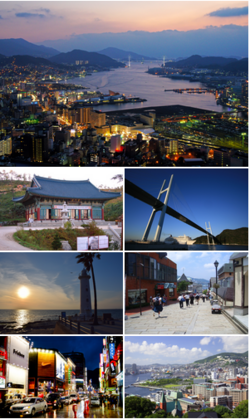Shindo: Difference between revisions
No edit summary |
No edit summary |
||
| Line 1: | Line 1: | ||
{{Infobox settlement | {{Infobox settlement | ||
| name = Shindo<br>新都 | | name = Shindo<br>新都 | ||
| settlement_type = {{wpl| | | settlement_type = {{wpl|City}} | ||
| image_skyline = Shindo City Montage.PNG | | image_skyline = Shindo City Montage.PNG | ||
| image_flag = Quelpart flag.png | | image_flag = Quelpart flag.png | ||
| Line 25: | Line 25: | ||
}} | }} | ||
{{nihongo|'''Shindo'''|新都|Shin-do}} is | {{nihongo|'''Shindo'''|新都|Shin-do}} is a city in [[Republic of Namsa|Namsa]]. It is the fourth-largest incorporated city in the country, with over 2,8 million residents. Situated on the [[Jedong]] region, it is the capital of [[Shin province]] and Namsa's biggest port. | ||
In 1501, general administrator [[Kim Sun]] designated the area now known as Shindo as the new capital. It quickly became one of the biggest cities in the {{wp|New World}}, and the main hub for cultural and economic exchange between eastern and western colonial powers. Shindo saw multiple raids and invasions througout its history, most notably the [[Japanese occupation of Shindo]]. The city became a hub of {{wp|tourism}} in the 18th century. After the [[Baekyeonhwa]], Shindo remained an important cultural hub for [[Republic of Namsa|Namsa]], but it no longer was the preferred destination for | In 1501, general administrator [[Kim Sun]] designated the area now known as Shindo as the new capital. It quickly became one of the biggest cities in the {{wp|New World}}, and the main hub for cultural and economic exchange between eastern and western colonial powers. Shindo saw multiple raids and invasions througout its history, most notably the [[Japanese occupation of Shindo]]. The city became a hub of {{wp|tourism}} in the 18th century. After the [[Baekyeonhwa]], Shindo remained an important cultural hub for [[Republic of Namsa|Namsa]], but it no longer was the preferred destination for Eastern settlers, as they moved towards the rapidly industrializing west. | ||
In 1900, Shindo lost its Capital City status and [[Sado]] became the Capital City instead. | |||
==History== | ==History== | ||
Latest revision as of 03:47, 14 April 2021
Shindo 新都 | |
|---|---|
 | |
| Nickname: The Western Capital | |
| Country | Republic of Namsa |
| Province | Shin Province |
| Establishment of the Capital | 1501 |
| Founded by | Kim Sun |
| Government | |
| • Mayor of Shindo | Se Jin-Myung |
| Area | |
| • Total | 1,023.8 km2 (395.3 sq mi) |
| Population (2019) | |
| • Total | 2,890,105 |
Shindo (新都 Shin-do) is a city in Namsa. It is the fourth-largest incorporated city in the country, with over 2,8 million residents. Situated on the Jedong region, it is the capital of Shin province and Namsa's biggest port.
In 1501, general administrator Kim Sun designated the area now known as Shindo as the new capital. It quickly became one of the biggest cities in the New World, and the main hub for cultural and economic exchange between eastern and western colonial powers. Shindo saw multiple raids and invasions througout its history, most notably the Japanese occupation of Shindo. The city became a hub of tourism in the 18th century. After the Baekyeonhwa, Shindo remained an important cultural hub for Namsa, but it no longer was the preferred destination for Eastern settlers, as they moved towards the rapidly industrializing west.
In 1900, Shindo lost its Capital City status and Sado became the Capital City instead.
History
Geography
Climate
Natural Disasters
Shindo lies between the North American Plate and the Caribbean Plate, making it prone to earthquakes and slippage which frequently affect the city. It is not uncommon for buildings to experience swaying.

